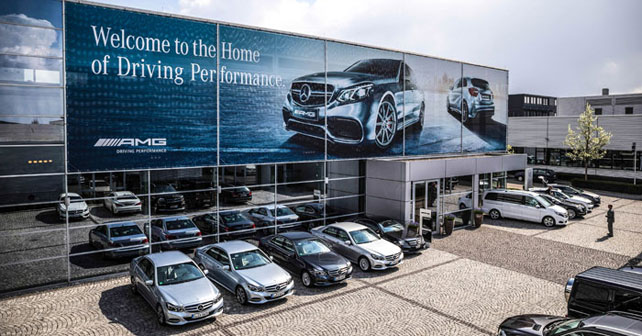The AMG factory may look inconspicuous from the outside, but the cars they produce are anything but!
We started the day at the Mercedes headquarters in Stuttgart enjoying a sunny, but crisp, morning and admiring the cherry blossoms in the courtyard. Inconspicuously positioned in the corner was the Benz Patent-Motorwagen. A strange thought occurred to me on seeing this museum piece relegated to one corner – what if Bertha, wife of Karl Benz, hadn’t gone against her husbands wishes and taken his creation for a 100 kilometre spin (the first long distance drive by an automobile) 128 years ago? Not only did she invent brake shoes en route, more importantly, she sealed the fate for the future of the automobile as we know it today. Momentous is far too mild a word.
Before I could gather my thoughts, we were on the road again. Half an hour later, we were in the German countryside, with lush green fields on either side of a two-lane road. We slowed as we approached a small town, before turning off into another courtyard – only this one was far smaller and was surrounded by fairly inconspicuous two-story buildings. Well, looks can be deceiving. We were in Affalterbach after all – home to Mercedes’s in-house tuning arm, AMG. As we went into a briefing room prior to a tour of the factory, I spotted a red pig in the corner. No, it’s not what you’re thinking – this one wasn’t roasted. This was a 1:18 scale model of the first machine developed by AMG – a 300 SEL with a massive 6.8 litre V8 that developed 420 horsepower. And, the rest, as they say, is history.
AMG, after all, is legendary for making some of the most thunderous powerplants in the world today. They even make the lust-worthy 6.0 litre bi-turbo V12 that produces 720 horsepower in the Pagani Huayra. We even got to see one of these engines being assembled at the factory, which is actually quite rare – since they only make about a dozen during the year (if that). While AMG started with race engines, they eventually started developing high performance variants of standard Mercedes road cars. One of the first cars they developed along with the factory was the famous AMG Hammer in 1986. This W124 E Class was the fastest sedan in the world at the time thanks to a 5.6 litre V8 that pumped out 360 horsepower. This engine, along with many other AMG masterpieces, was on display at the factory.
AMG still follows the ‘One Man, One Engine’ philosophy, where (presumably) one very skilled technician walks along a high tech assembly line with a single engine virtually from start to finish. Such is the precision that the entire engine assembly building is pressurized to 1.5 bar. As a result, when someone opens a door, air flows out and not the other way around – so as to ensure that no contaminants sneak in from outside (even the building is high-performance!).
AMG, now, is fully assimilated within Mercedes-Benz. They even have their own models – the SLS, and now the AMG GT – and the AMG range is a huge part of the overall strategy of the Group. They’re no longer a handful of engineers making go-faster bits in a shed. This is now a massive operation. But, somehow, that essence – that purity of a speed shop – remains. This is still fuelled by a bunch of very passionate and highly skilled people doing what they do best – making the meanest Mercs on the planet. Amen to that!




























Write your Comment